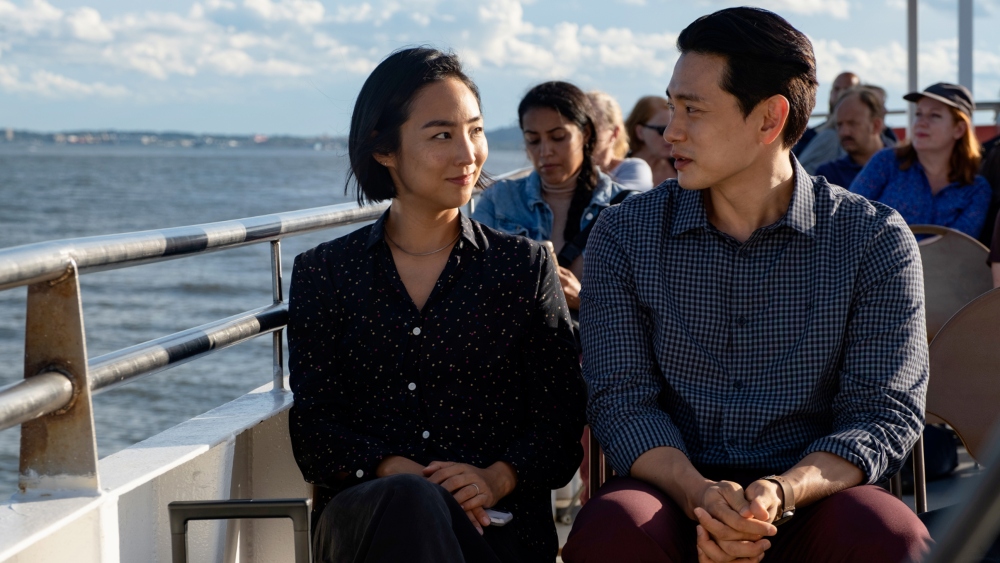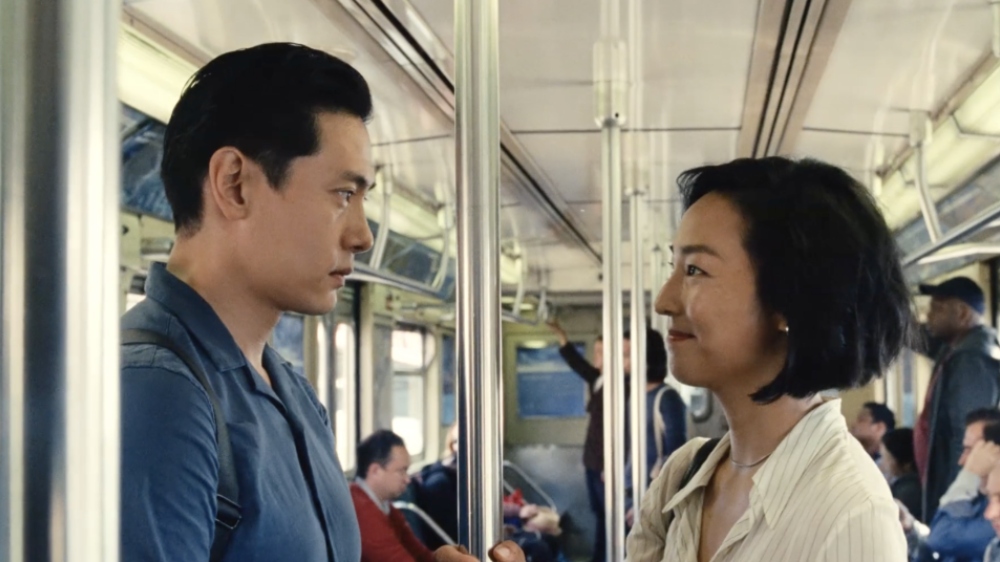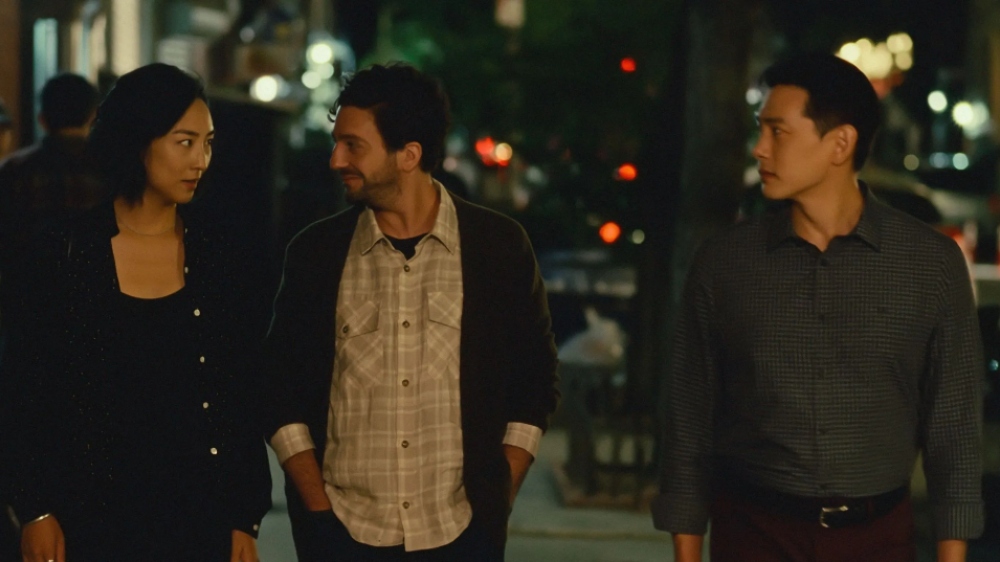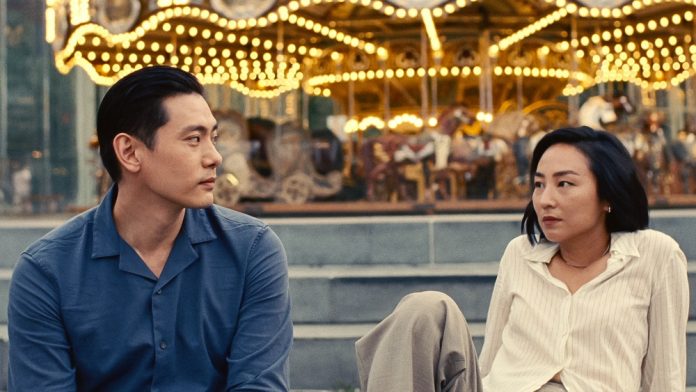In Past Lives, two childhood friends reconnect after more than a decade apart, picking up right where they left off — or as close to it as possible.
Greta Lee stars as Nora, a writer who moves from Seoul to Vancouver to New York for the benefit of her career. She leaves behind Hae Sung (Teo Yoo), who remains in South Korea until he sets out on a journey to New York after finding Nora on the internet years later.
Past Lives shows what happens when they meet again, this time in Brooklyn. One of the best-reviewed movies of the year, it marks the first film from writer-director Celine Song, and debut features are rarely this assured and confident. As such, the film was acquired by indie powerhouse A24 out of Sundance, and it’s now playing in theaters nationwide.
Above the Line recently jumped on Zoom to speak with filmmaker Celine Song, who talked about memories, procrastinating, and fighting off crowds on the streets of Manhattan.

Above the Line: I know you based the script in part on your personal experiences. How much of the story did you know before you started writing?
Celine Song: Well, my process is I usually procrastinate for a really long time. I sort of let it marinate for months. I watch reality TV and just sit on it. I’m sure you can relate.
The first thing I wrote for this, and this is not always true for me, was the first scene of the movie, where the three leads are sitting at a bar. From there I knew what the structure would be. I knew that near the end we would come back to this first scene and finally get to hear what the three of them are talking about. And for us, the audience, to have a whole new context for the story.
I wrote the first scene, and then the very last two scenes, including the one where Nora walks home. After that, I could go back and write the rest of the movie. I don’t think I could have started properly if I hadn’t done it that way.
ATL: One of the many things I loved about the script are the ellipses, the things you leave out. Can you talk about stripping out all the non-essential narrative elements?
Song: At the end of the day, the thing I’m asking for in every moment of the movie is, “Does this tell the core story? Does it have a connection to the core story?” And if it doesn’t, is there another way to show it? When it comes to connecting the dots or following an emotional thread, I think the audience is always so much more sophisticated than we give them credit for. So, if some things were not directly connected to the core narrative, I decided they had to go.
The biggest ellipses in the film are the two 12-year jumps in time. 12 years is a long enough period for a character to become a new person in some ways. And I wanted to point out the contradictions in time. 12 years feels like forever, or it can feel like that [snapping her fingers]. It can seem like yesterday, or it can feel like such a long time that you are a completely different person.
So the 12-year gaps became my way of showing what Nora and Hae Sung are going through and how their connections have changed. To me, that is the heart of the story.

ATL: Most writers and directors are tempted to show too much, to explain the artists’ colony, or a student delivering a story pitch in a class. You didn’t succumb to that.
Song: The specificity of things that maybe you don’t know much about [or that maybe you do], I think the audience is open to them through context. I thought the audience could go along with certain scenes because of the context. With just a few words or images, they’ll think, “This is what a writers’ residency is like.” If you’ve actually been to a residency, you might think, “Wow, this is a secret I have with the movie that maybe nobody else really understands.”
That happens with the Korean details too. I don’t know if the audience in America will understand some of those details, but it’s part of building that world for them. Maybe they will connect by learning a little bit about what it is like in Korea.
ATL: At the same time, if you don’t get the details exactly right, you could lose viewers.
Song: You know, it drives me crazy when apartments in New York City aren’t right. I remember on locations, scouts walking into apartments that are worse than the apartments you see in the movie. I would walk into this shithole and I’d be like, ‘Let’s shoot it here.’ [laughing] Of course, my COVID officer would say, ‘Absolutely not. Nobody can fit in here.’ We shot this on 35mm film, with a massive camera, so my crew would complain that the camera wouldn’t fit on the staircase.
Okay, we’d find another shithole and I’d be like, ‘This is perfect.’ Everyone would say, ‘It’s too small, it’s too shitty.’ Finally, we landed on this railroad flat where at least you could get a little depth with the camera. It was the right solution for the picture, but because it was a shithole as well, the floor creaked every time the camera moved. Our poor sound editor had to delete all these creaks.

ATL: Speaking of visuals, tell me about working with your cinematographer Shabier Kirchner.
Song: The love story of Past Lives is the one between me and Shabier. He’s not just an unbelievably talented image maker, he’s also a storyteller — someone who’s connected to both story and character. In working with him, I loved how I wouldn’t have to explain that sometimes the better-looking image isn’t the priority. He always knew to tell the story first and foremost.
I relied on him so much to help develop the language of the film. We didn’t want to make an homage [to] another movie. We pulled ideas, but we wanted Past Lives to have its own language that speaks on its own.
Shabier and I had an amazing chemistry. I’ll give you an example of his work ethic. For that street scene at the end, my task for the location was to find something that’s a totally mundane, average, normal-looking street in New York City. One you might walk by without noticing. But it also had to be this extraordinary, beautiful, stunning, perfect representation of the movie, something that could speak for the whole story. It had to be both of those contradictory things.
Because it’s so subjective, you can’t just send a scout out looking for it. I mean, what is it? How do you say? It had to have this ineffable quality, and not be a landmark either. So after our office would wrap prep every night, Shabier would go out to the East Village looking for this street. Every night, walking around for two weeks until he found it.
His devotion to the project [and] his creative eye were indispensable to making this movie. I would tell him he makes me feel 10 feet tall. I had the biggest weapon having him work with me.
ATL: You used some unorthodox rehearsal methods, separating actors from each other at times. I’m curious how you work with them on set. Do you shoot a lot of takes?
Song: It depends. I have to see a take I feel is going to be in the movie, and then I usually let them do one more before we stop. Usually, it ended up being between three to six takes, something like that. Mostly four or five takes. I’d give notes in between, but eventually, you get to the point where the actors already know what the note’s going to be. Towards the end, I would come up to Greta and she’d say, ‘Got it. I already know.’
When the target you’re pursuing is so small, you want to be there with the actor to be able to know exactly what [you’re] trying to hit. Sometimes it’s only a matter of “Give me some more color,” something I can paint with in the editing.
That scene with Arthur [John Magaro] in the bar, I told him, ‘I put a six-minute magazine in the camera, and I’m going to use all six minutes just on your face. Teo and Greta will be doing their scene next to you, but we’re just going to be on your face. We’re not going to move the camera. I want you to give me everything you can think of.’ He’s such a great actor that he could give me, like, 10 different kinds of listening, and transition beautifully between them.
When I was in [the] edit, I had every possible color of his performance to pull from. I actually chose a piece that was one of his transitions, because the ambiguity ended up being the right temperature for the scene. So, sometimes I’m looking for something that hits the target, and sometimes I need a few colors.

ATL: The German title is In einem anderen Leben, In Another Life. That’s how I connected to your movie, by remembering all of the hopes and dreams that I’ve lost.
Song: I don’t think you have to be a Korean-Canadian-American woman to connect to the story. We all know what it’s like to go through time and space in our lives. We all have relationships that endure and relationships that end. We all have that in common.
ATL: You make some tough choices here, like holding on a shot of Hae Sung and Nora standing on a sidewalk.
Song: It was self-evident to me that this was the moment everyone was waiting for. In fact, so much of the movie is waiting for this point. Everyone was so hungry for it because of the restraint in the rest of the movie. I think that walk is the most spectacular thing in the film.
ATL: There’s a similar moment in Nebraska, and I remember Bruce Dern talking about the courage Alexander Payne showed to hold onto the shot as long as he did.
Song: I didn’t necessarily feel that courageous [laughing], I felt like it was the right thing to do. We don’t even have that much coverage of the scene. I always intended to shoot it that way. Shabier and I believed in it from the start.
ATL: It’s a tough shot to get — moving camera on a New York street at night.
Song: We had to clear every building and lay 150 feet of track. If one car was parked illegally, the whole shot was gone. My gaffer, Jay Kemp, is unbelievably stressed because he has to light this dark, dark street. And of course, it’s a Friday night in the East Village. On either side of the frame, there are so many drunk people, [and] people screaming, “Is this Spider-Man?”
Plus, the actors have to do this really emotional material. We start the shot from the steps of the apartment building, then go down the block. And at the end of every take, Greta has to cry. She has to do this scene over and over again, crying at exactly the right moment every time.
While they were waiting for an Uber, this little piece of wind came up. We didn’t have a wind machine, so it was like a miracle. It just fucking showed up for it. I was cueing the Uber with my hand because I didn’t want the actors to know when it would arrive. I was feeling out when the car would break the spell. It had to feel like an eternity but also too quick. When the wind showed up, it was perfect.
Past Lives is now playing in select theaters courtesy of A24.



